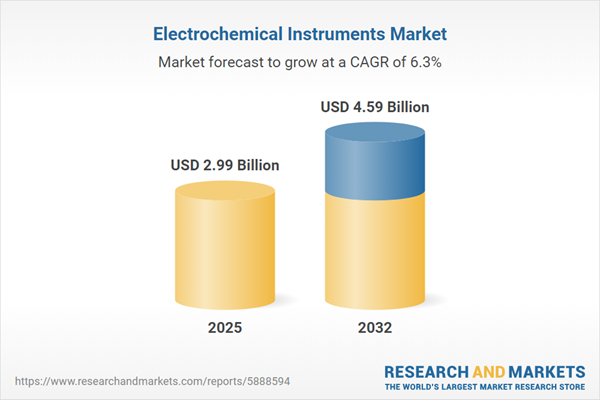Speak directly to the analyst to clarify any post sales queries you may have.
The electrochemical instruments market is transforming precision analysis and industrial process control, supported by expanding applications across key end-use industries. Decision-makers evaluating technological investments and strategic sourcing benefit from thorough insights into evolving trends, innovation drivers, and market challenges.
Market Snapshot: Electrochemical Instruments Market Growth and Dynamics
The electrochemical instruments market grew from USD 2.81 billion in 2024 to USD 2.99 billion in 2025. It is projected to continue expanding at a CAGR of 6.29%, expected to reach USD 4.59 billion by 2032. Demand for these instruments is shaped by shifts in industrial regulation, technology integration, and ongoing investment in process optimization across pharmaceuticals, environmental monitoring, food and beverage, and chemical industries.
Scope & Segmentation
This report provides a comprehensive examination of the electrochemical instruments market across core segments and operating environments:
- Instrument Types: Conductivity meters (benchtop, in-line, portable), corrosion analyzers (electrochemical impedance spectroscopy, linear polarization, Tafel extrapolation), dissolved oxygen meters, ion selective electrode analyzers, pH meters, potentiostats/galvanostats, titrators.
- Application Segments: Academic and research, environmental monitoring, food and beverage, petrochemicals, pharmaceuticals, water treatment, and wastewater management.
- End Users: Academic institutions, government laboratories and agencies, healthcare clinics and hospitals, industrial sites (chemical, food & beverage, oil & gas, power generation), laboratory R&D, and quality control teams.
- Product Types: Benchtop instruments, online analyzers (in-line, on-line), portable analyzers (battery operated, handheld).
- Regional Coverage: Americas (North America, Latin America), Europe, Middle East & Africa (including detailed country-level breakdowns), Asia-Pacific (China, India, Japan, and key Southeast Asian markets).
- Participating Companies: Analysis includes Thermo Fisher Scientific Inc., Danaher Corporation, Mettler-Toledo International Inc., Metrohm AG, Shimadzu Corporation, Agilent Technologies, Inc., Horiba Ltd., Endress+Hauser AG, PerkinElmer, Inc., and Bio-Rad Laboratories, Inc.
Key Takeaways for Senior Decision-Makers
- Technological innovation is expanding detection capabilities while enabling more streamlined, real-time monitoring in both laboratory and remote field applications.
- Demand is increasing for modular and eco-efficient instrument designs, in response to global sustainability initiatives and stricter environmental regulations.
- Digital integration through cloud connectivity and automation is transforming maintenance models, empowering remote data access and predictive servicing to reduce downtime.
- Strategic supplier diversification and regional production hubs are supporting enhanced supply chain resilience amid global disruptions and changing trade policies.
- Industry consolidation continues, with leading manufacturers acquiring specialist firms and expanding service partnerships to offer broader value-added solutions.
- End-user requirements are diversifying, emphasizing the need for tailored solutions across segments such as academic research, industrial quality control, and healthcare diagnostic monitoring.
Tariff Impact on Cost Structures and Supply Decisions
New United States tariffs introduced in 2025 are creating elevated landed costs for imported electrochemical instruments and components. The resulting shift is compelling stakeholders to diversify supplier networks and consider domestic manufacturing or regional assembly to manage risks. Organizations are adapting procurement strategies, often evaluating rental or leasing models to maintain agility and manage capital outlay amid evolving trade policies.
Methodology & Data Sources
This analysis integrates primary interviews with key industry leaders, procurement experts, and end users, supported by extensive secondary research of technical literature, industry reports, and regulatory publications. Quantitative data was validated through triangulation against shipment records, while qualitative trends were synthesized using thematic analysis and established market assessment frameworks.
The Importance of the Electrochemical Instruments Market Report
- Guides strategic investment with segmented growth forecasts and actionable market intelligence for C-suite decision-making.
- Informs sourcing and procurement strategies by detailing regional variations, tariff impacts, and shifting end-user priorities.
- Supports product and portfolio planning by identifying trends in technological adoption, regulatory alignment, and evolving service models.
Conclusion
With its in-depth segmentation and actionable insights, this report empowers senior leaders to navigate complex market shifts, identify new growth opportunities, and future-proof their organizational strategies within the electrochemical instruments sector.
Additional Product Information:
- Purchase of this report includes 1 year online access with quarterly updates.
- This report can be updated on request. Please contact our Customer Experience team using the Ask a Question widget on our website.
Table of Contents
3. Executive Summary
4. Market Overview
7. Cumulative Impact of Artificial Intelligence 2025
Companies Mentioned
The companies profiled in this Electrochemical Instruments market report include:- Thermo Fisher Scientific Inc.
- Danaher Corporation
- Mettler-Toledo International Inc.
- Metrohm AG
- Shimadzu Corporation
- Agilent Technologies, Inc.
- Horiba Ltd.
- Endress+Hauser AG
- PerkinElmer, Inc.
- Bio-Rad Laboratories, Inc.
Table Information
| Report Attribute | Details |
|---|---|
| No. of Pages | 185 |
| Published | October 2025 |
| Forecast Period | 2025 - 2032 |
| Estimated Market Value ( USD | $ 2.99 Billion |
| Forecasted Market Value ( USD | $ 4.59 Billion |
| Compound Annual Growth Rate | 6.2% |
| Regions Covered | Global |
| No. of Companies Mentioned | 11 |









